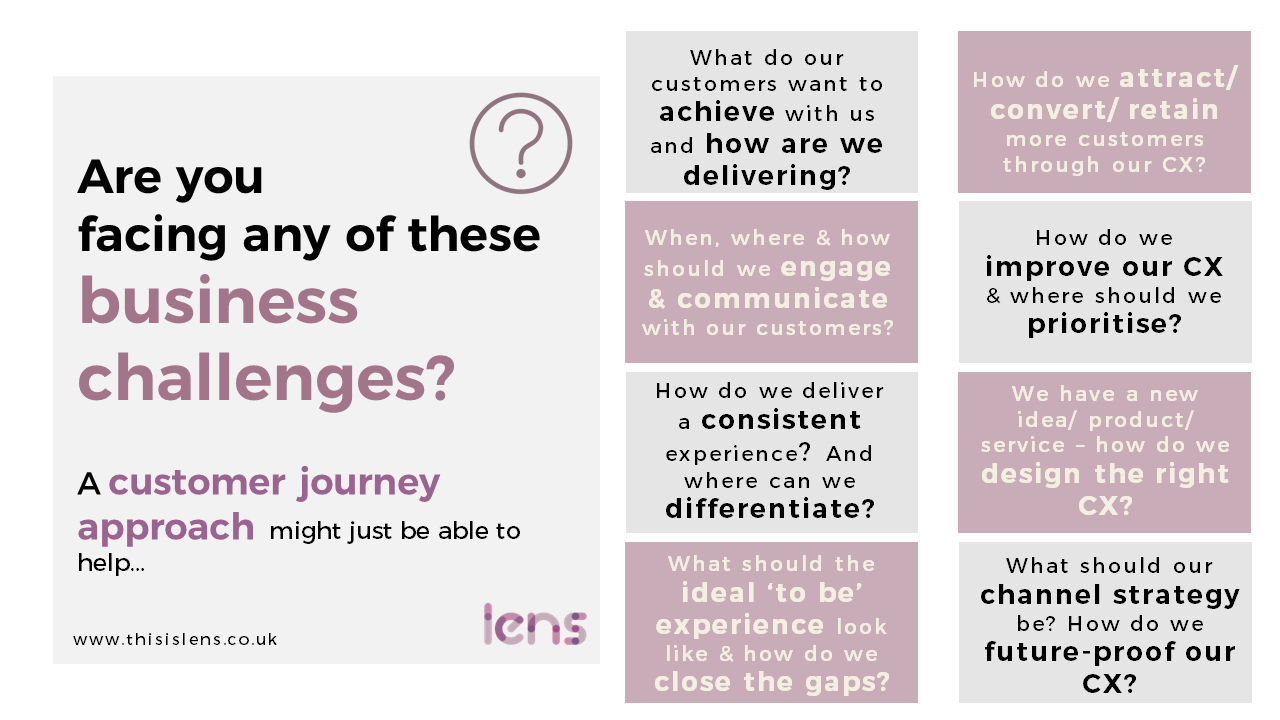What can a customer journey approach help your business to achieve?
Our clients come to us at many different starting points and with a range of different business challenges. Here is a summary of just some of the questions that a customer journey approach has helped our clients to answer…
- What do our customers want to achieve with us and how are we delivering? Customer journeys are defined by customer goals (intended outcomes). Defining your journeys from a customer perspective identifies why your customers are engaging with your brand – and the goals that you do/ don’t currently help them to achieve. The extent to which you’re delivering against customer goals should be an ongoing measure of success
- How do we attract/ convert/ retain more customers through our CX? Many businesses, particularly those with a digital presence / focus, have lots of data on where customers come in to / ‘drop out’ of their CX; however, it is only when we take a journey approach that we truly understand why customers come in or ‘drop out’. This is often due to the cumulative impact of different touchpoints or the extent to which the business is meeting customers’ rational/ emotional needs throughout the experience
- When, where & how should we communicate with our customers? The comms / contact strategy and the customer journey are intrinsically linked. A CRM strategy should also therefore be aligned around the customer journey and should be both an input and output of a customer journey mapping exercise
- How do we improve our CX and where should we prioritise? The customer journey is a framework that enables businesses to connect all relevant sources of data and insight – customer, operational, and commercial. This provides a business with a holistic picture and enables prioritisation and decision-making
- How do we deliver a consistent experience? And where can we differentiate? Many businesses have a brand promise and a CX vision…and some may also have a set of CX principles. An understanding of customer journeys is then required to ensure that a) these are delivered consistently across the customer lifecycle and b) the business is able to identify the key moments where they can differentiate the experience through ‘signature actions’ that tie into the brand
- We have a new idea/ product/ service – how do we design the right CX? With start-ups and fintech businesses on the rise, innovation is all around us! An approach that applies the principles of design-thinking will be invaluable here; taking a human-centred approach and starting with the ‘jobs-to-be-done’, overlaying the possibilities of technology and the requirements for business success
- What should the ideal ‘to be’ experience look like and how do we close the gaps? With industry trends/ changes (e.g. open banking), innovation and competitor activity in mind, businesses are understandably looking to the future – understanding the ‘as is’ versus desired ‘to be’ customer journeys informs the CX roadmap and clear actions required to achieve the business’ aspirational state
- What should our channel strategy be? How do we future-proof our CX? There are lots of emerging channels and new tech. that can support the delivery of the CX – AI, machine learning, chatbots, and the ‘internet of things’ (IoT) are all hot topics. However, just because we can, doesn’t mean we should - a customer journey approach helps to understand the role of different channels and tech. across the CX and identifies where digital is key vs. where phone/ F2F human contact (etc.) is required by customers
Is your business currently facing any of these challenges? We’d love to hear from you if you’d like to chat through your challenges and how a customer journey approach might be able to help…


